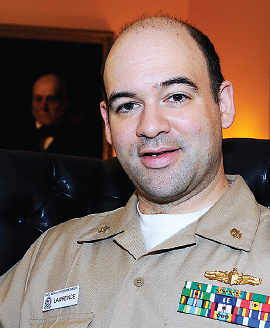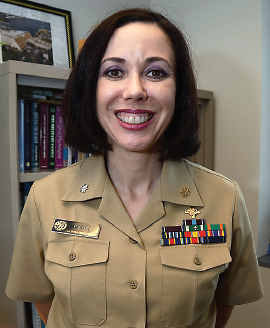On the morning of September 16, word began to spread around the Naval Medical Center in Portsmouth, Va., about the shooting at the Washington Navy Yard. By 6 p.m. that afternoon, 13 members of a Navy Special Psychiatric Rapid Intervention Team (SPRINT) were driving north, not knowing the scope of the job facing them or the time they’d be away from home.
The deadly incident at the Navy Yard was exactly the reason for which the SPRINT was conceived 20 years ago: to provide “short-term mental health and emotional support immediately following a disaster or traumatic event.”
The Portsmouth SPRINT in the past has responded to incidents from Hurricane Katrina to the Virginia Tech shooting to an auto accident in which several members of a Navy helicopter squadron died. (A second SPRINT is based in San Diego.)
“Our goal is making understandable the expectable response,” said Cmdr. Duane Lawrence, a psychiatrist and 18-year Navy veteran who spent much of 2012 at a NATO base in Kandahar, Afghanistan. Lawrence now serves as head of the Operational Forces Mental Health Liaison in the Directorate for Mental Health at the Naval Medical Center, Portsmouth.
The team consists of psychiatrists, psychologists, social workers, nurses, chaplains, Navy neuropsychiatric technicians, and U.S. Public Health Service personnel. All have regular clinical or administrative jobs in the Navy’s medical system, but meet several times a year to train or review past deployments for lessons learned.
The SPRINT arrived in Washington, D.C., the night of September 16 and spent the next day coordinating plans with the other federal, state, and local agencies that also responded to the shooting, said Cmdr. Ingrid Pauli, Ph.D., in an interview. Pauli is a clinical psychologist who served in the Navy for nine years and is now with the U.S. Public Health Service. The team also drew on former SPRINT members now based at Bethesda Naval Medical Center.
“On Wednesday, we went to the Navy Yard and began walking through the base, just talking to people,” she said. “We had lots of requests for group sessions.”
They spoke to more than 90 percent of the employees in Building 197, where the shooting took place. Over the next three weeks, the team had close to 9,000 individual encounters with workers and conducted about 300 group sessions.
“We explained that the sessions were not mandatory, that we were not diagnosing anyone, not doing psychotherapy, and not taking notes,” said Pauli. “But we’d watch out for folks who seemed to be having an extra hard time and talk to them afterwards to try to link them up with local resources.”
“We try to help people recognize any problems and allay their concerns by decatastrophizing and destigmatizing their reactions,” said Lawrence in an interview with Psychiatric News.
The SPRINT members’ goal was to help those who chose to process their response to the incident by talking about what they experienced and to explain that their reactions were normal under the circumstances—“to assess and normalize and not pathologize,” she said.
As a psychiatrist, Lawrence was often asked by Navy Yard personnel “what if” questions: “If I see a psychiatrist later, how will taking medications affect me and my career?”
“The impact is usually minimal,” he could tell them.
SPRINT members also looked out for each other as they spent those weeks listening to a lot of difficult stories. Over meals together, they talked over what they heard during the day. Sometimes spending a few hours doing administrative work provided a needed break.
Late in the second week after the shooting, the team hit its peak—51 group sessions in one day—and then the numbers began to decline.
“It’s homeostasis,” said Pauli. “People just want to get back to routine, back to normal.”
They returned to Portsmouth on October 3, but not before connecting those who needed or wanted more help with local mental health resources in the surrounding area.
“It was a great opportunity to help break down barriers when human beings are going through a very human experience,” said Lawrence. “I find it humbling to help with healing in the midst of tragedy.” ■


